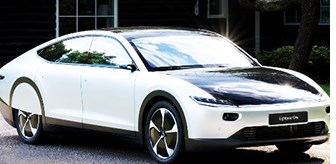Driving on Sunshine: Solar Powered EVs
Dutch partners aim to boost EV range with solar panels
#hybrid
A pair of Dutch companies, Lightyear and Royal DSM, are working to scale up their solar panel technology for use in electric vehicles.
The partners claim the technology could generate enough energy to provide as much as 70%-90% of an EV’s range… if the conditions are right and driving is limited to about 25 miles per day.
Lightyear One Launch
Lightyear demonstrated the system last summer on its “One” prototype. A production version of the $136,000 sedan is due to bow next year.

The sporty five-seater features a 54-sq-ft solar panel array that spans the hood, roof and rear window. Lightyear claims the panels are 20% more efficient than solar arrays used for supplemental power in other vehicles.
The EV’s range is estimated to be about 725 km (450 miles) on the European driving cycle. Nearly half the distance can be derived from the solar panels, according to the carmaker.
How it Works
In addition to powering auxiliary components, Lightyear’s system provides energy directly to the battery, whether the car is moving or stationary. The solar cells are protected by double-curved safety glass that the company says is strong enough to support an adult walking on them without causing any denting.
Lightyear was founded in 2016 by engineering students from the Technical University of Eindhoven, who previously won the Bridgestone World Solar Challenge. The company has more than 20 patents related to the solar panel technology.
DSM provides conductive coating, which enables the solar cells to adhere to the back of the panels. The design optimizes surface utilization and reduces electrical (cell-to-module) losses, which the supplier says boosts power output by 3%.
The One also features four independent in-wheel motors. Technical specifications haven’t been released.
What’s Next?
In addition to the low-volume One (production will be capped at 500 units), Lightyear is developing several lower-cost EVs. These vehicles will be geared toward car-sharing applications and are expected to have high levels of autonomy.
Lightyear and DSM hope to land development programs to test the technology with other carmakers. The partners plan to eventually use the panels in a range of EVs, including cars, vans and buses.
Solar Competition
Several other carmakers already offer or are testing solar panels on select models.
Toyota began equipping some variants of its Prius plug-in hybrid sedan with solar arrays in 2017 to power accessory systems and partially charge the battery. Last year, the carmaker began testing a more advanced system that can power the Prius for 35 miles on a sunny day.
Audi, Hyundai and Karma Automotive also have solar programs in the works.
But none are as ambitious (or costly) as the Lightyear One. At this point, a $136,000 novelty EV from an unknown Dutch startup seems like a stretch…if not light-years away.
RELATED CONTENT
-
On Traffic Jams, Vehicle Size, Building EVs and more
From building electric vehicles—and training to do so—to considering traffic and its implication on drivers and vehicle size—there are plenty of considerations for people and their utilization of technology in the industry.
-
Internal Combustion Engines’ Continued Domination (?)
According to a new research study by Deutsche Bank, “PCOT III: Revisiting the Outlook for Powertrain Technology” (that’s “Pricing the Car of Tomorrow”), to twist a phrase from Mark Twain, it seems that the reports of the internal combustion engine’s eminent death are greatly exaggerated.
-
Honda to Make Hybrids in Thailand
Honda Motor Co. is preparing to launch production in Thailand of hybrid cars and the batteries that help power them.

